Subscribe now and get our latest blog and video content delivered straight to your inbox.
Cords and Face Cords: Firewood Size Guide

Apr 19, 2024

Firewood storage and seasoning are vital to good wood burning. To get maximum efficiency out of your firewood, it’s important to store it correctly and let the moisture evaporate from it. It’s typically wise to aim for wood with a moisture content below 20%.
Since firewood dimensions and weight tend to vary quite a bit from log to log, it’s easier to talk about firewood storage in terms of one large stack of logs. These stacks are composed of units called cords. Firewood is typically cut, bought, and sold in these units (or fractions of them).
But what is a cord? How many logs are in a cord? How much does a cord weigh? And how are cords divided to measure smaller stacks of firewood more precisely?
In this guide, we’re going to answer all of those questions and more. By the time you’re finished here, you’ll know everything you need to know about cord sizes, dimensions, and weights so you know exactly how much firewood you need.
Use these links to jump to different cord sizes on this page:
Cord of Wood Dimensions
Let’s start with an overview and work our way down. There are generally five units of cord measurements used to describe firewood storage:
- A full cord
- 1/2 of a cord
- 1/3 of a cord (also called a face cord)
- 1/4 of a cord
- 1/6 of a cord (also called a ½ face cord)
It’s helpful to think about cords of wood in terms of a few familiar measurements:
- Weight of a cord of wood
- Number of logs in a cord of wood
- Volume of a cord of wood
- Dimensions of a cord of wood (in terms of both inches and feet)
The chart below lays out all of this information for the five most commonly used cord wood measurements:
|
Cord of Wood |
1/2 Cord of Wood |
Face Cord of Wood |
1/4 Cord of Wood |
1/2 Face Cord of Wood |
|
|
Weight (Pounds) |
3,000 - 5,000 |
1,500 - 2,500 |
1,000 - 1,600 |
750 - 1,250 |
500 - 800 |
|
Number of Logs |
600 - 800 |
300 - 400 |
200 - 270 |
150 - 200 |
100 - 140 |
|
Volume (Cubic feet) |
128 |
64 |
42⅔ |
32 |
21⅓ |
|
Dimensions (Inches) |
96x48x48 |
96x48x24 |
96x48x16 |
48x48x24 |
48x48x16 |
|
Dimensions (Feet) |
8x4x4 |
8x4x2 |
8x4x1⅓ |
4x4x2 |
4x4x1⅓ |
While that’s essentially all there is to it, let’s dive a bit deeper into each unit of measurement to help understand a little bit more about them.
Full Cord of Wood
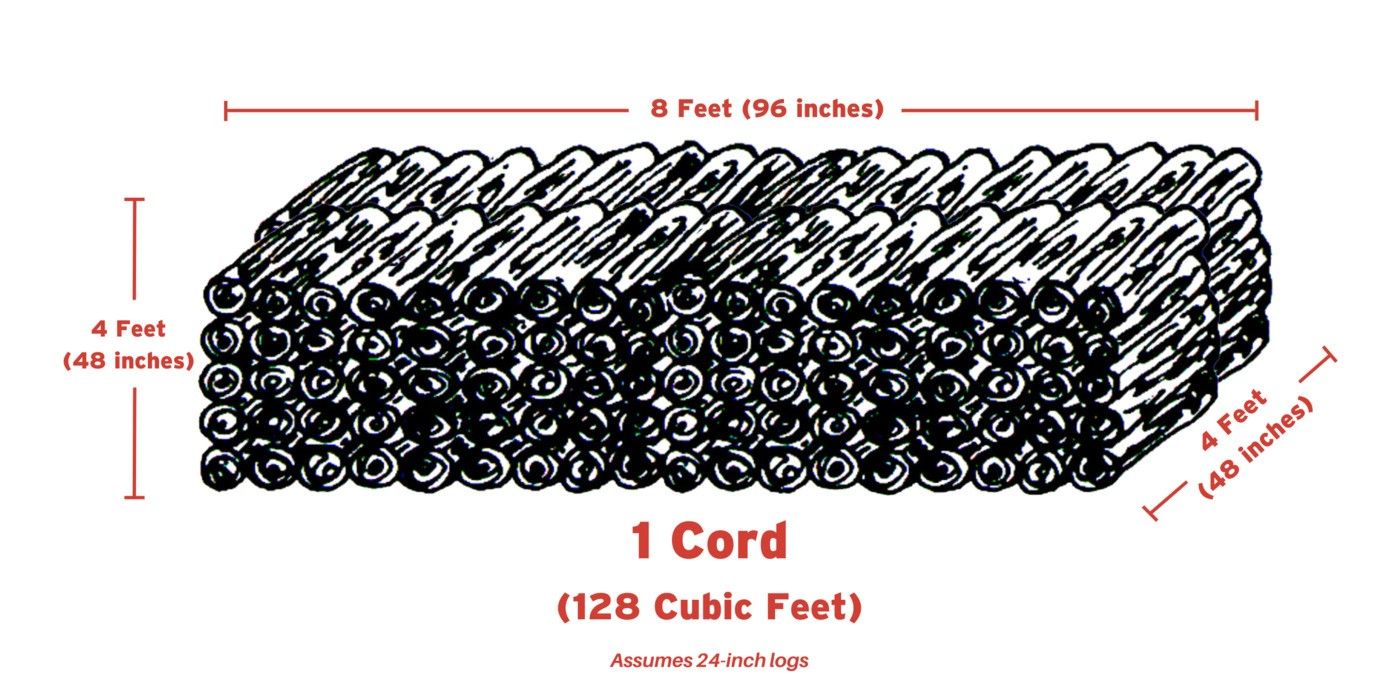
Overview:
- Weight: 3,000 - 5,000 pounds
- Number of logs: 600 - 800 logs
- Volume: 128 cubic feet
- Dimensions (inches): 96” x 48” x 48”
- Dimensions (feet): 8’ x 4’ x 4’
A cord of wood comes out to 128 cubic feet of wood. It’s common for the firewood in the cord to be stacked four feet high, eight feet wide, and four feet deep. Many manufacturers fabricate their firewood racks to accommodate these dimensions.
Depending on the length of your firewood, the dimensions of your cord of wood may be slightly different. What most determines a cord is its size in cubic feet; a cord of wood will always come out roughly to 128 cubic feet.
The weight and number of logs in a cord vary quite considerably, too. Log weight changes due to moisture level. Moist logs with high water content weigh considerably more, but if you store and season your logs correctly, they’ll weigh less as more water evaporates. Also, depending on the length, width, and height of your logs and how you stack them, you may wind up with anywhere from 600 to 800 logs in a cord.
Usually, a cord can have either two or three rows of logs. If you’re stacking 16” logs, you’ll wind up with three rows of logs for a total of 48” (or 4 feet) of depth. If you’re stacking longer 24” logs, you’ll wind up with two rows of logs (again reaching 4 feet of total depth).
1/2 Cord of Wood
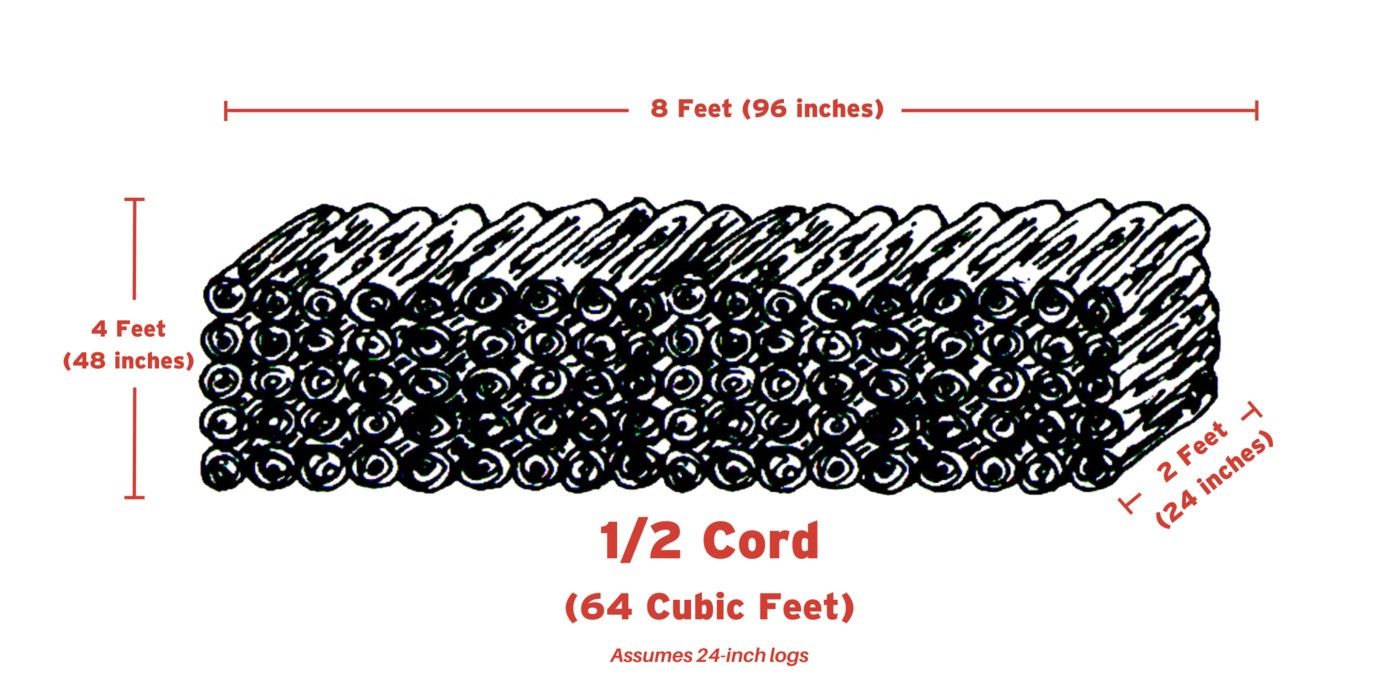
Overview:
- Weight: 1,500 - 2,500 pounds
- Number of logs: 300 - 400 logs
- Volume: 64 cubic feet
- Dimensions (inches): 96” x 48” x 24”
- Dimensions (feet): 8’ x 4’ x 2’
A 1/2 cord of wood is simply a cord cut in half. Again, the number to pay attention to is volume, and a 1/2 cord will contain about 64 cubic feet of firewood. A 1/2 cord of wood tends to measure about four feet high, eight feet long, and two feet deep.
With a 1/2 cord, you begin to see just how important a role wood length plays in determining the size of your wood stack. In order to constitute a 1/2 cord, the firewood in the stack needs to measure about 24” in length (for a total of 2 feet of depth).
Face Cord of Wood
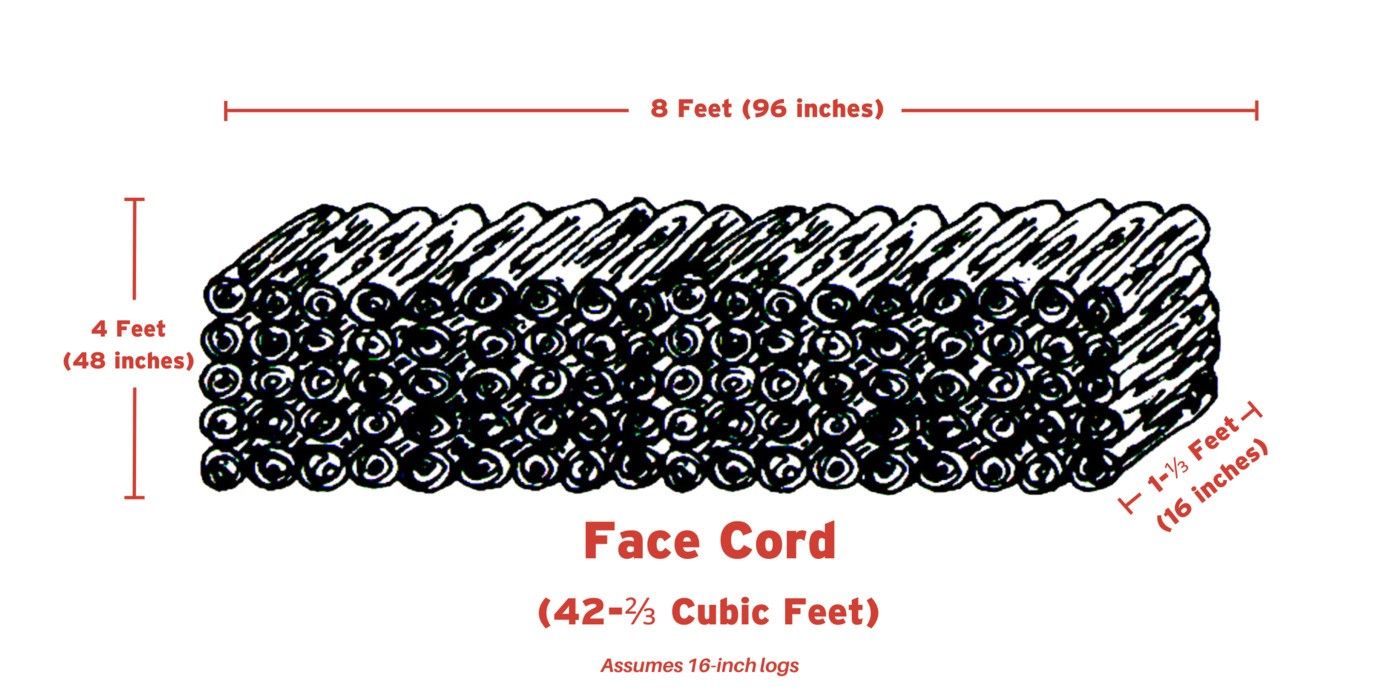
Overview:
- Weight: 1,000 - 1,600 pounds
- Number of logs: 200 - 270 logs
- Volume: 42⅔ cubic feet
- Dimensions (inches): 96” x 48” x 16”
- Dimensions (feet): 8’ x 4’ x 1⅓’
A face cord is 1/3 of a cord. It’s called a face cord because the height of the stack (four feet) and the length of the stack (eight feet) — the dimensions of the “face” of a full cord — remain unchanged. The difference, again, is log length. 16” logs stacked four feet by eight feet comprise a face cord.
Once again, the weight of a face cord can vary by hundreds of pounds depending on how well-seasoned (or not) the firewood is. Also, depending on the width and height of your firewood, a face cord may contain anywhere from 200 to about 270 logs.
1/4 Cord of Wood
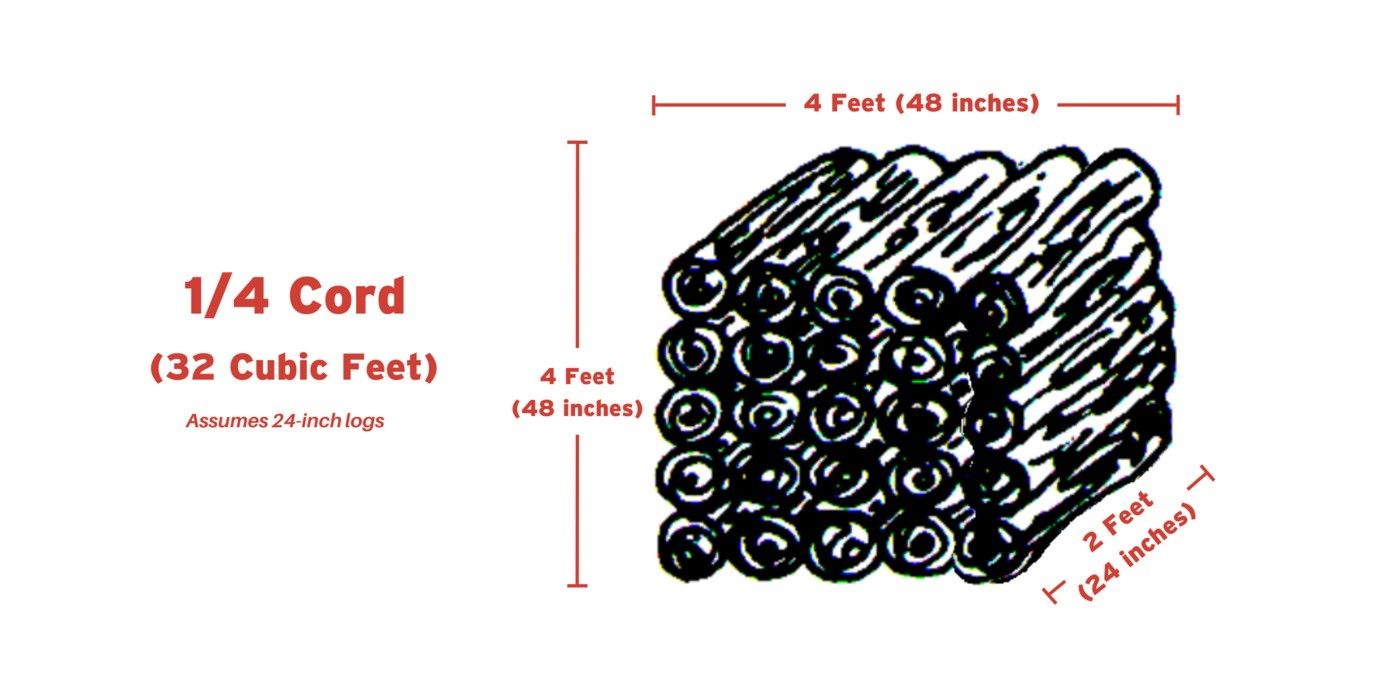
Overview:
- Weight: 750 - 1,250 pounds
- Number of logs: 150 - 200 logs
- Volume: 32 cubic feet
- Dimensions (inches): 48” x 48” x 24”
- Dimensions (feet): 4’ x 4’ x 2’
1/4 of a cord is just what it sounds like — a cord of wood split into fourths. Instead of the typical eight-foot length of a full cord, a 1/4 cord tends to be about four feet wide. Like a full cord or a 1/2 cord, a 1/4 cord typically uses logs that are about two feet in length.
A 1/4 cord is a decent amount of wood for a moderate wood burner. If you light around 20 to 25 fires in your fireplace through the burning season, 1/4 cord should be able to get you through.
1/2 Face Cord of Wood
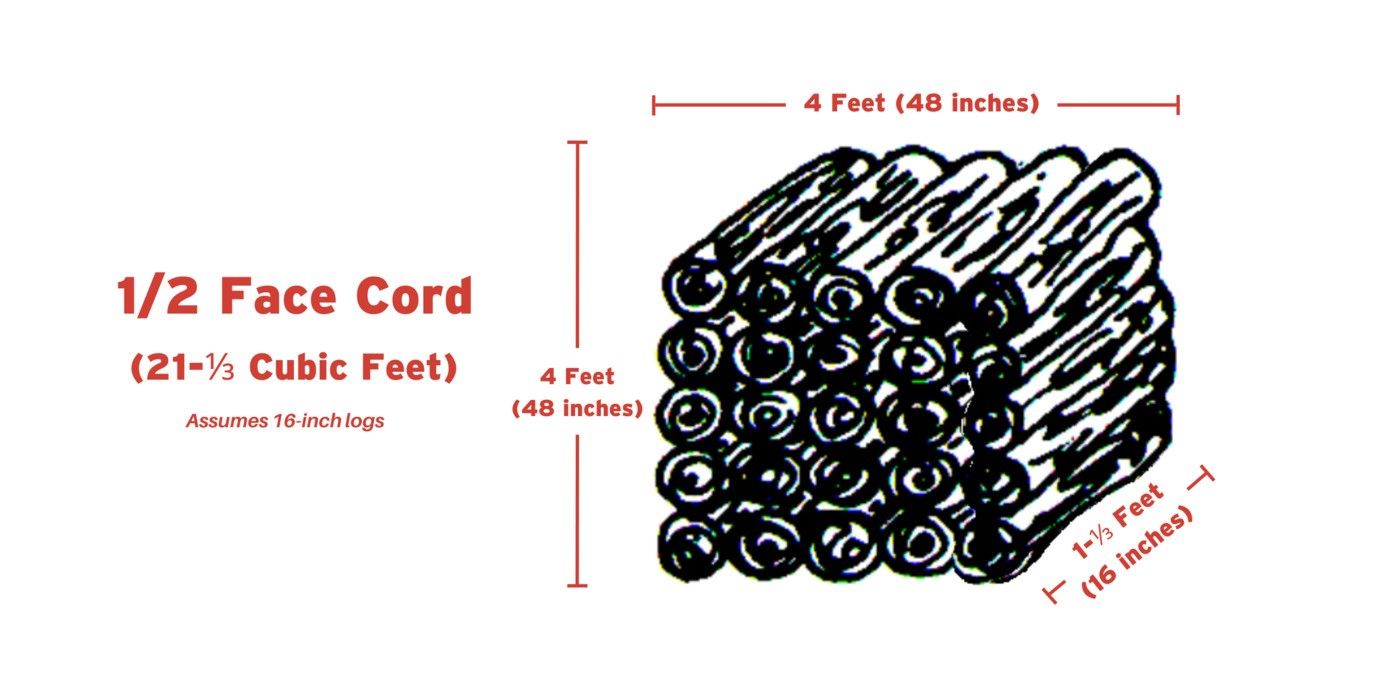
Overview:
- Weight: 500 - 800 pounds
- Number of logs: 100 - 140 logs
- Volume: 21-⅓ cubic feet
- Dimensions (inches): 48” x 48” x 16”
- Dimensions (feet): 4’ x 4’ x 1⅓’
Finally, the smallest unit on this list is the 1/2 face cord (also known as 1/6 of a cord of wood). Like the 1/4 cord, a 1/2 face cord generally measures about four feet tall and four feet wide. Similarly to a face cord, the logs in a 1/2 face cord stack tend to be about 16 inches in length.
Clocking in at just over 21 cubic feet, a 1/2 face cord is the perfect amount of firewood for light wood burners. If you only use your fireplace a few times a year, 1/2 of a face cord is plenty to get you through.
How Should You Store Your Firewood?
And that’s everything you need to know about cords of wood. All the dimensions are driven from the original 128-cubic-feet full cord. From that unit, it’s just a matter of changing a width here or a length there to wind up with the right amount of wood to get you through the burning season.
But what’s the best way to store your stack of firewood?
Our guide to best burn practices covers that topic in depth. From splitting, stacking, covering, and storing wood, it’ll help you understand how to burn your firewood with maximum efficiency.
Also, it’s never a good idea to pile your wood on the ground. That exposes it to insects, critters, and the buildup of moisture due to precipitation. The optimal way to store your firewood to prevent these problems is by using a log rack.
At HY-C, we manufacture log racks that can hold over a full cord of firewood — and we make them right here in the USA. Find yours today by using our product locator!
Overview:Weight: 3,000 - 5,000 pounds
Number of logs: 600 - 800 logs
Volume: 128 cubic feet
Dimensions (inches): 96” x 48” x 48”
Dimensions (feet): 8’ x 4’ x 4’
